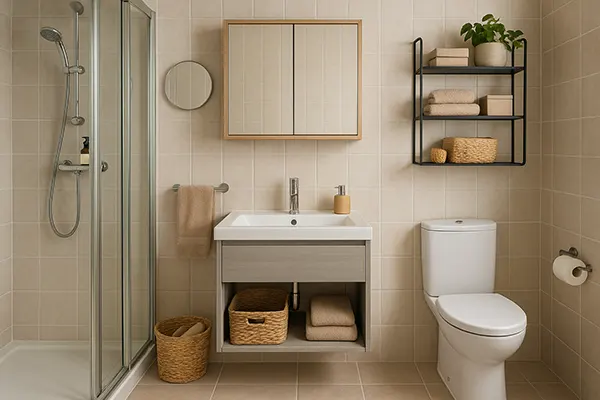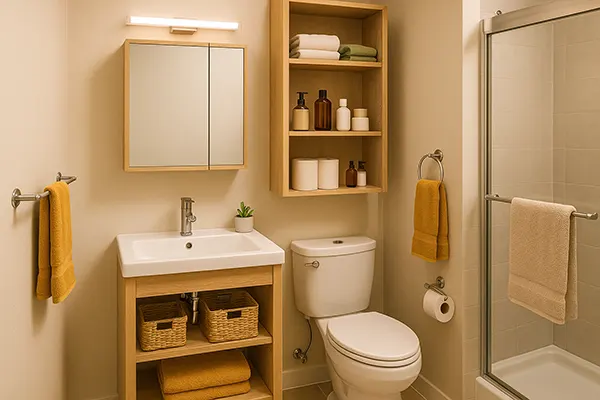
How to Organise an Efficient Storage System in a Small Bathroom
A compact bathroom often challenges homeowners to balance practicality with comfort. Limited surfaces, tight wall areas, and minimal cabinet space make everyday routines less convenient. Yet, with a considered approach that maximises vertical zones, optimises hidden compartments, and incorporates multifunctional elements, even the smallest bathroom can support an orderly and efficient system. Thoughtful planning helps ensure that every object has a designated place without overwhelming the limited layout.
Assessing Available Space and Planning the Layout
Before choosing containers or furniture, it is essential to study the room’s existing layout. Understanding traffic flow, door swings, and the placement of the sink, toilet, and shower helps determine where storage units can be positioned without blocking movement. Precise measurements are vital, as even a few centimetres can affect how cabinets or shelves fit.
Many small bathrooms lack built-in cupboards, so analysing vertical zones becomes particularly important. Walls above the toilet, beside the mirror, or over the door frequently remain unused. These areas can accommodate narrow shelving that enhances capacity without affecting comfort. Planning also includes exploring corners, which often become wasted sections despite their potential.
Another key aspect is deciding which belongings require daily access and which can be stored higher or deeper. By identifying priority items, homeowners can create an arrangement that reduces clutter and saves time during morning routines. This approach lays the groundwork for a functional system that supports long-term order.
Choosing Storage Solutions Built for Small Bathrooms
Compact bathrooms benefit from storage designs that maximise every centimetre. Narrow cabinets with adjustable shelves can accommodate toiletries of different sizes, while slim pull-out organisers fit well between existing fixtures. These pieces allow households to store several categories of items without overcrowding the room.
Wall-mounted units remain among the most effective choices for small interiors. Floating shelves, corner brackets, mirrored cupboards, and towel rails create additional capacity without occupying floor space. Items stay accessible while the room preserves an open, tidy appearance. Opting for durable materials that withstand humidity is equally important, as this prolongs the lifespan of the furniture.
Multifunctional items, such as mirrored cabinets with integrated lighting or benches with concealed compartments, offer practical flexibility. They reduce the number of objects needed in the bathroom, helping to maintain a clean and organised environment. This approach is especially beneficial when several household members share a single small room.
Using Vertical Zones to Expand Storage
Vertical zones often determine how effectively a small bathroom can accommodate everyday essentials. Installing shelving along the walls up to ceiling height increases capacity without occupying additional floor area. These upper shelves work well for storing spare towels, cleaning goods, and bulk products that do not require daily access.
The area above the toilet provides an excellent opportunity for raised cabinets or tiered racks. These solutions remain within easy reach yet do not interfere with movement around the room. Choosing shallow models prevents the space from feeling overcrowded while still providing adequate storage for frequently used items.
Hooks, magnetic strips, and hanging organisers also contribute to a more efficient use of vertical space. They allow small accessories such as razors, brushes, or cosmetic tools to remain tidy and visible. This method helps prevent overfilling drawers and keeps countertops clear, which is particularly important in compact interiors.
Incorporating Hidden and Multi-Purpose Compartments
Hidden compartments offer valuable support in maintaining a clean and uncluttered appearance. Under-sink cabinets with pull-out trays make it easier to categorise cleaning supplies, haircare tools, and spare toiletries. These trays improve visibility and minimise the risk of items becoming lost behind larger bottles.
Mirrored cabinets with internal dividers provide an organised space for cosmetics, medicines, and grooming products. Because the storage is integrated into the wall, it does not require additional room and keeps essential items protected from humidity. Adjustable shelves allow users to tailor the internal configuration to their specific needs.
Furniture with dual functionality, such as stools with storage cavities or compact trolleys that roll beneath the sink, enhances flexibility. These solutions offer extra capacity without creating visual clutter. Multi-purpose pieces are particularly useful in small households where practicality must remain constant despite spatial limitations.

Maintaining Order Through Categorisation and Routine
An effective storage system relies on clear categorisation. Assigning each group of items to a dedicated section helps reduce the likelihood of clutter returning. Toiletries, grooming accessories, towels, and cleaning supplies should all reside in separate containers or compartments, ensuring the bathroom remains orderly even during busy mornings.
Transparent containers or baskets with labels help identify stored items quickly. This approach minimises time spent searching for essentials and prevents unnecessary overcrowding. Materials such as acrylic, silicone, or woven fibres suit humid conditions well and maintain their quality over time.
Maintaining order also requires a consistent routine. Reviewing products regularly, removing expired items, and adjusting storage locations according to changing needs helps the room stay tidy. A small bathroom becomes significantly easier to manage when belongings remain categorised and when each item has a consistent place.
Ensuring Long-Term Efficiency with Smart Habits
Incorporating small habits into everyday routines ensures the bathroom stays organised. Returning items to their designated sections immediately after use prevents surfaces from becoming crowded. This practice also simplifies cleaning, which is especially beneficial in compact rooms.
Monitoring the number of products stored in the bathroom helps prevent accumulation. Keeping only necessary items at hand and relocating less frequently used goods to other household spaces ensures the bathroom remains spacious and manageable. Limiting duplicates further reduces clutter and supports a minimalist approach.
Finally, periodically re-evaluating the overall layout ensures the system continues to meet the household’s needs. Small adjustments, such as adding an extra hook or swapping containers, can have a significant impact on usability. A flexible, well-thought-out arrangement ensures the small bathroom remains efficient and comfortable throughout the year.
